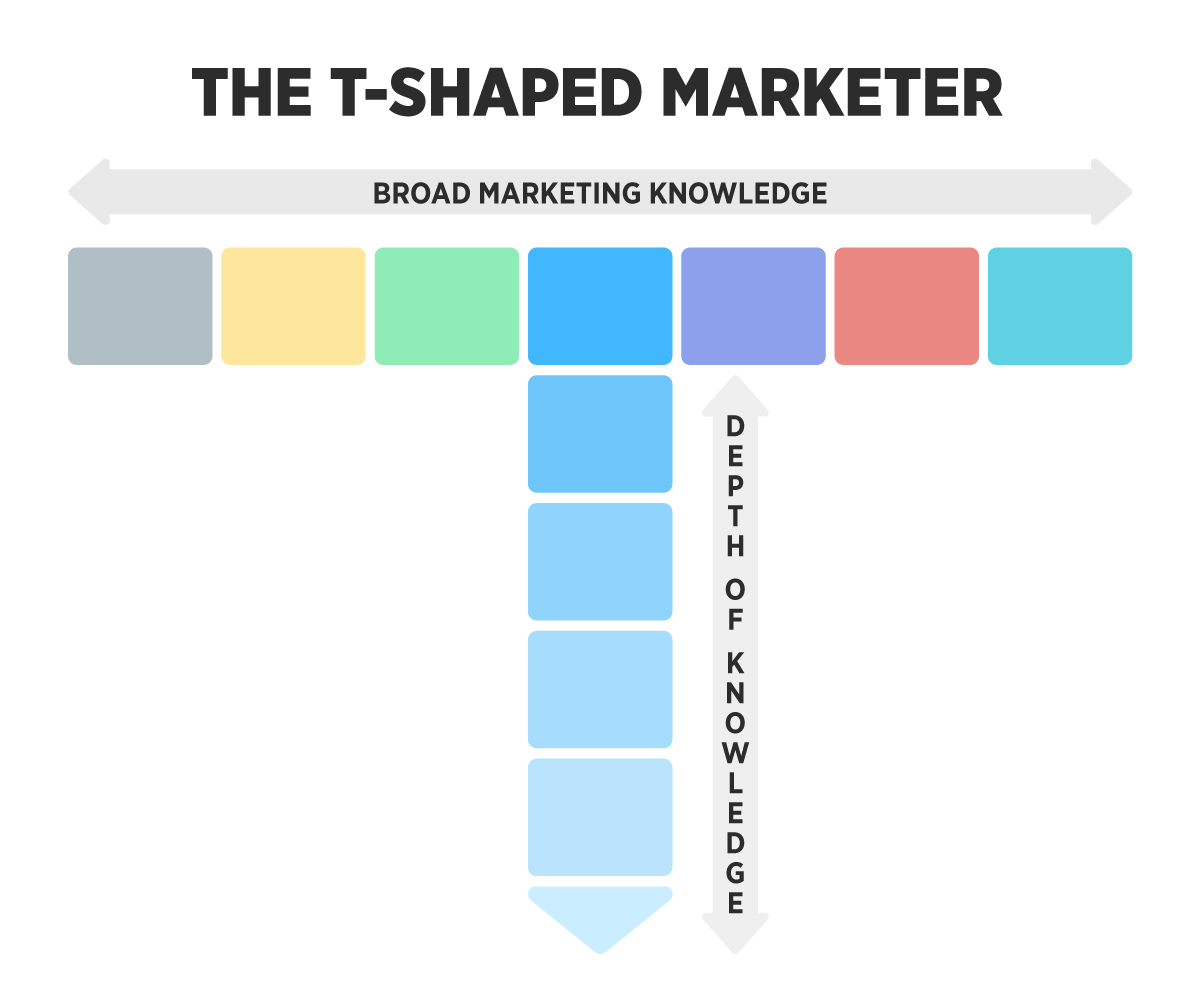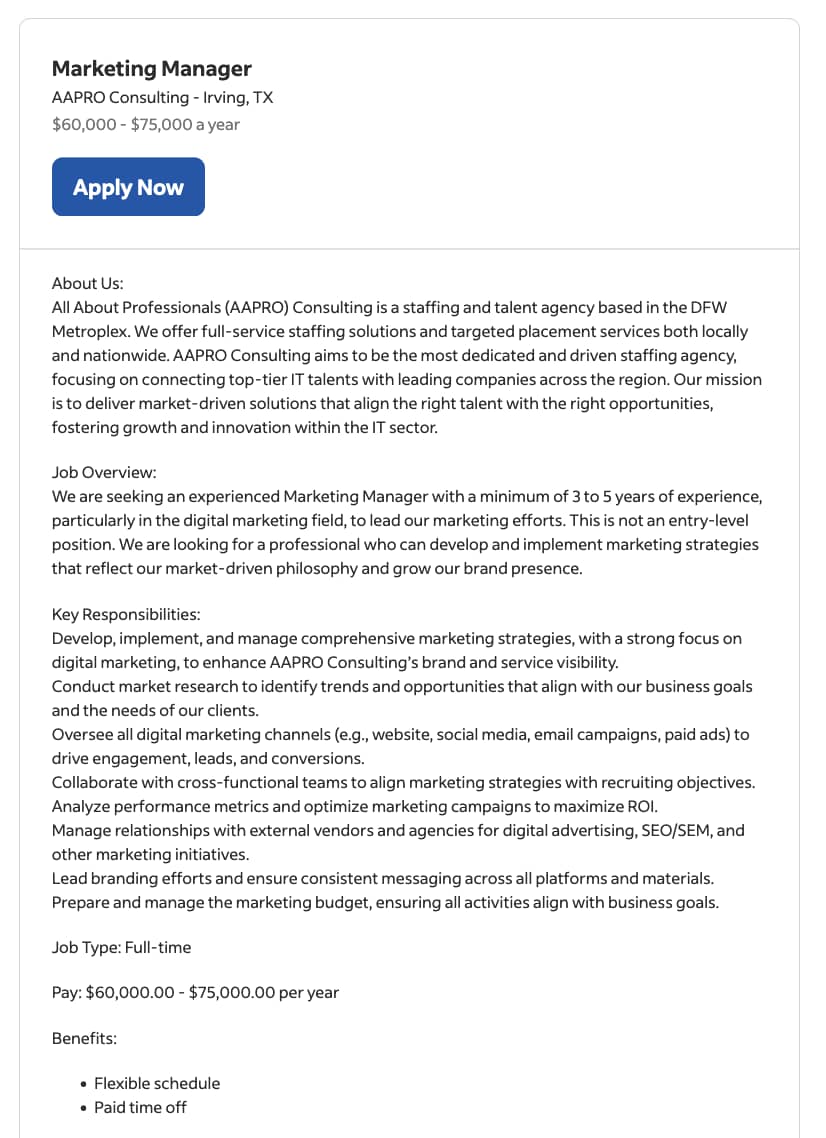Our view at Stack - Pipedrive is a robust CRM platform, offering automation, contact data collection, webhooks, AI-powered sales assistant, email communications, email marketing, and customisable sales pipeline workflows.
Running a growing business means overseeing various critical functions, including marketing.
As a business leader with a small sales team and limited freelance support, it’s normal to feel that your marketing efforts aren’t reaching their full potential.
In this guide, you’ll learn how effective marketing management helps you continuously attract and engage new customers. Along with a simple definition of marketing management, you’ll find all the ingredients of a solid marketing plan and some of the best tools to help you optimize ROI.
What is marketing management?
Marketing management is the process of planning and overseeing a company’s marketing activities to ensure they’re organized, data-driven and aligned with broader performance objectives.
As a small business leader or manager, effective marketing management helps you to consistently reach your target audience and squeeze the most value from your available resources.
Depending on your skill level and availability, you might be a marketing manager for your own business or employer or delegate the role to a contractor or team member.
Alternatively, you could control the strategy in-house and outsource execution to an agency.
However you do it, the key activities involved in marketing management include:
-
Planning campaigns. Creating strategies for promoting your products or services across different channels such as social media, email and search engines.
-
Managing marketing channels. Overseeing the performance of marketing activities such as social media, search engine advertising, your website and email marketing.
-
Tracking and analyzing performance. Using applications like Google Analytics to monitor campaign outcomes and make data-driven decisions to improve them.
-
Adjusting strategies. Modifying your approach based on customer feedback and performance data to achieve better results and maximize your resources.
For example, imagine you run a financial services business.
As a marketing manager, you plan a social media campaign to promote your business services during tax season. It involves setting goals, targeting your audience and posting original content on Instagram and LinkedIn.
Using a reporting tool (e.g., Google Analytics or a CRM), you track marketing metrics like traffic, engagement and sales to learn what’s working. Seeing that Instagram performs better than Facebook (perhaps because more of your audience uses it), you allocate more resources there and overall engagement increases.
Regularly monitoring and adjusting your approach like this ensures you get the most out of your marketing spend and aid business growth.
Recommended reading

A beginner’s guide to common marketing abbreviations
The small business benefits of effective marketing management
Effective marketing is essential for small business leaders who want to grow their companies and stay competitive.
Here’s how managing those marketing efforts strategically, instead of just promoting irregularly, will help your company thrive.
Increased brand visibility
The more consistent your marketing efforts, the easier it’ll be for potential customers to find your business.
Maximizing visibility means regularly updating your social media channels, maintaining a strong online presence with search engine optimization (SEO) and effectively using paid ads.
Regularity is almost impossible without someone accountable for (i.e., managing) your company’s marketing function. Without a marketing manager, you risk marketing becoming an afterthought, deprioritized behind team members’ other responsibilities.
For example, running targeted Facebook ads allows you to reach new customers quickly based on location or demographics within your budget – it’s ideal for increasing attention and getting short-term results.
Meanwhile, optimizing your website for search engines and creating content is a longer-term investment. While it requires more effort, SEO helps you build a sustainable source of organic traffic, setting your business up for future growth.
Anyone searching “screenshot tool” on Google, for instance, will see Lightshot ahead of Microsoft, a much bigger brand with greater spending power.

This visibility, which helps Lightshot attract new customers, is down to the dedication and consistent efforts of its marketing manager and team.
If you took an ad hoc approach to marketing, you’d struggle to build momentum and your business would always be less visible than its more organized and consistent competitors.
More customer engagement and retention
Strategic marketing management also helps you nurture relationships with existing customers.
By structuring your use of channels like email marketing and social media, you can regularly engage your customer base by providing valuable content, special offers or tailored recommendations.
For example, hosting company Namecheap uses carefully scheduled email marketing campaigns to boost repeat business. Here’s an example of it encouraging renewals:

Likewise, engaging with customers through social media – replying to comments or hosting giveaways – helps keep your business in mind.
Without a consistent strategy, making your company name familiar to your target market would be much harder as your interactions would be sporadic.
Stronger brand identity and messaging
Having one person manage marketing efforts makes it much easier to keep messaging consistent across various channels. It means someone can implement their vision and have a final say.
This consistency is vital for building trust and maintaining a professional image, aiding profitability.
In a Marq survey, 68% of business representatives said brand consistency had contributed to between 10% or more of their revenue growth.

Whether it’s your email newsletter, social media or product marketing content, customers should feel like they’re interacting with the same brand every time.
For example, the clothing brand Rapanui reinforces its sustainability value proposition across all its digital marketing channels, including its website:

Rapanui promotes similar themes on its social media profiles. Wherever customers or prospects interact with the brand, they get the same message about what makes the company different.
This kind of clear, consistent brand storytelling helps customers connect with brands on deeper levels, which can boost loyalty and trust over time.
Improved marketing ROI
By tracking and analyzing your campaigns from the top down, you can identify what works and what doesn’t, helping you allocate your resources more effectively and optimize profitability.
For example, if you find that Google Ads generates more leads for your sales team than Facebook ads, you can adjust your budget accordingly to maximize results.
Similarly, tracking your email open and click-through rates (CTRs) might show that some subject lines or content formats lead to more engagement, helping refine your strategy and lower customer acquisition costs (CAC).
This kind of high-level management is proven to make marketers more effective. A CoSchedule survey found that organized marketers are almost seven times more likely to report success than their peers.

However, without such controlled oversight and analysis, it’s easy to waste time and money on marketing efforts that don’t deliver results. You’ll find yourself guessing until something works by chance.
Recommended reading

What is inbound marketing? Definition, examples and strategies
What goes into a basic marketing plan?
A marketing plan ensures that your business promotion efforts are structured, measurable and aligned with company objectives.
Your plan will be unique to your business, with your objectives guiding every element. However, the fundamental building blocks are the same for all companies.
With that in mind, here’s how to build a strong marketing plan in five simple stages.
1. Set clear objectives and KPIs
Start by defining your marketing goals and key performance indicators (KPIs).
Your goals should be specific, measurable and aligned with your broader business ambitions. Your KPIs are the metrics you’ll use to measure progress toward those goals.
For example, goals to increase website traffic by 20% and generate 50 new leads monthly will support the broader objective of expanding your market share.
Your KPIs for those web traffic and lead-gen goals could be metrics like website visits, email open rates and new deals created.
Alternatively, you might focus on churn rates and customer satisfaction (CSAT) scores to increase customer retention.
You’ll find all these measurements in sales and website analytics tools like Pipedrive and Google Analytics.
Note: SMART is a helpful framework for ensuring goals are specific, measurable, achievable, realistic and time-based. It’ll give your marketing efforts more direction while helping you track progress effectively.
2. Define your market segments
Targeting distinct groups will help you create highly relevant marketing content that’s more likely to resonate and drive action.
When forming your business plan, you’ll have already identified your primary target audience. However, you can be more precise by creating multiple buyer personas based on demographic, psychographic and behavioral characteristics.
Better understand your customers with our Buyer Persona Templates
Use these templates to ensure your solution always aligns with your customers’ interests and needs
For example, Semrush is an SEO software company that separately targets marketing agencies and small businesses.
Focusing on “client value” is how Semrush’s marketers speak to agency users’ needs and make the company’s product more appealing.

Other agency challenges it addresses include managing clients and freelancers, reporting on performance and integrating other marketing tools.
Meanwhile, the company targets business owners with content on local SEO, a common and valuable task for smaller companies.

Both Semrush’s audiences are valuable to the company but require different messaging and information to nurture them through the sales funnel.
Note: Campaigns’ segmentation tool lets you filter your email list based on engagement and demographic data. Use it to ensure the right messages reach the right people at pivotal moments in the customer journey.
3. Outline marketing channels (and plan tactics)
Next, choose how you’ll reach your target audience.
Social media, email and content marketing can all provide reach for very little money, making them ideal marketing channels for small businesses with tight budgets.
To get the most out of these channels, you’ll need to know how to use each one effectively and have the right technology available.
Once you’ve settled on channels, you can outline specific strategies for each one.
For example, you might post visual content on Instagram to target younger user segments, discuss industry news on LinkedIn to reach business-to-business (B2B) decision-makers and send sales promotion emails to engage existing customers.
4. Budget and allocate resources
Most small businesses have limited resources, so it’s important to allocate funds carefully. Otherwise, you risk overspending and affecting other functions.
Your budget will need to cover some or all of the following costs, depending on which channels and strategies you’ve chosen:
-
Paid advertising (e.g., social media and search ads)
-
Market research and market analysis
-
Software subscriptions
-
Learning resources (e.g., courses and books)
-
Website hosting and maintenance
-
Email marketing services
-
Premium social media accounts (e.g., LinkedIn Premium)
Once you’ve determined your budget, decide how much time you (or your team) can devote to each activity.
Your project management software should help with this, especially if it has a “workload” view or similar. Here’s what that looks like in ClickUp:

Alternatively, consider hiring part-time help or outsourcing tasks like graphic design or content creation.
Outsourcing lets you prioritize core business activities (or the marketing tasks you’re best at) while ensuring your marketing efforts stay consistent and professional.
As you scale, you’ll likely need a dedicated manager to ensure consistency and free capacity. You may even read this guide and think there’s too much to manage alone. We’ll discuss when and how to hire a marketing manager shortly.
5. Monitor and evaluate results
Use analytics and reporting tools to see how your marketing contributes to revenue growth and other performance objectives.
Metrics like CTR, engagement and conversion rate help you understand which strategies lead to sales and which need improvement.

For example, if your blog posts aren’t driving much traffic to your website, you might need to adjust your SEO strategy or revisit your content topics.
Alternatively, if most of your users click through to your site from social media, it’s a sign that you should keep using that channel and strategy.
It also suggests there’s an appetite for the topics you cover on social media, so turning the most effective posts into long-form content for your site could help you achieve further engagement.
Many marketing management tools include reporting features to help you collect, understand and act on performance data. Some of the most helpful and accessible are Pipedrive, Campaigns and Google Analytics. We’ll cover these and more in detail shortly.
Recommended reading

Create an effective marketing automation strategy and improve your ROI
When and how to hire a marketing manager
As your business grows, marketing responsibilities may become too much for one person to handle. At this point, hiring a marketing manager or outsourcing specific tasks becomes a smart move.
You’ll know it’s time to hire a dedicated marketing department or manager when any or all of the following things happen:
-
You spend more time on marketing than critical business operations, causing those other aspects to suffer. For example, you neglect product development or customer relationships to work on a social media marketing concept.
-
Your marketing efforts don’t produce the expected results, and general strategic adjustments aren’t helping. For example, your email campaigns have low open rates and tweaking subject lines or content themes hasn’t improved engagement.
-
You plan to scale your marketing and need an expert to apply their skill and be accountable for the results. For example, you want to launch new campaigns across multiple platforms but don’t have the bandwidth or expertise to manage them effectively.
Hiring a marketing manager is like any other type of small business recruitment. It involves identifying the necessary skills, finding candidates and verifying their suitability.
Here’s how to hire a marketing manager when ready to level up your marketing.
Step 1: Identify essential marketing manager skills
A strong marketing manager will have diverse marketing skills, including content creation, SEO, social media management and public relations.
Experience in various areas allows them to oversee all your marketing processes rather than just focusing on one area – this is where a “T-shaped” marketer becomes invaluable.
T-shaped marketers have broad knowledge across multiple marketing disciplines (like SEO, content and social media) and deep expertise in one or two areas.

The combination equips them to manage various tasks while diving deep into the most impactful strategies, ensuring your marketing efforts are balanced and effective.
If the person you hire will eventually oversee a larger marketing team, they should also have strong people and project management skills. Some companies use “marketing director” for more senior leadership roles like this.
Step 2: Create and publish a job advertisement
Once you have your ideal candidate in mind, you can craft a job advertisement to generate interest in the role.
Take inspiration from other companies in your sector for this. For example, here’s one for a marketing manager at a recruitment business:

Avoid copying other companies’ job descriptions word for word. Part of making your marketing position appealing is selling your company and its ambitions. Ensure these are in your post’s “about us” and “overview” sections.
Once complete, you can publish your job ad on recruitment sites like Indeed or social media. LinkedIn is particularly helpful for connecting with marketing professionals.
Note: “Marketing manager” and “brand manager” are similar roles with some important distinctions. Most marketing managers oversee marketing campaigns, strategies and daily activities, while brand managers focus on maintaining their companies’ identities and reputations.
Step 3: Interview the best candidates
Ask candidates open-ended questions that invite them to demonstrate their expertise and problem-solving skills.
For example, you could ask how they’ve handled underperforming campaigns in the past or how they prioritize tasks in a busy marketing environment.
You’re not necessarily looking for right and wrong answers here – the goal is to identify qualified candidates who can contribute new ideas and help your business grow its market share.
Recommended reading

Hiring Salespeople: How to Create the Perfect Sales Recruitment Strategy
Final thoughts
Careful marketing management is one of the pillars of sustainable business growth.
By organizing your marketing efforts with effective management, you’ll boost your online visibility, have more productive customer interactions, and ultimately see better returns on your marketing investments.
Whether you’re managing everything on your own or ready to hire help, use the tips and tools in this guide to streamline your marketing and free time to focus on running your business.
If Pipedrive is of interest and you'd like more information, please do make contact or take a look in more detail here.
Credit: Original article published here.
